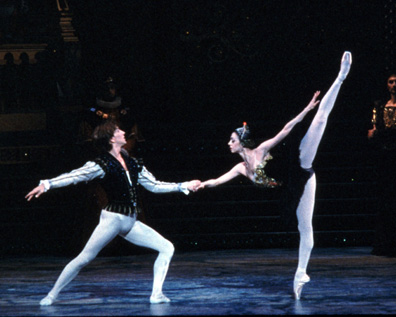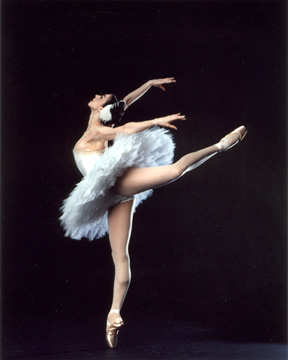Swan Lake
with Nina Ananiashvili and Julio Bocca
American Ballet Theatre
Metropolitan Opera House
June 18, 2004
by
Leigh Witchel
copyright
© 2004 by Leigh Witchel
published June 21, 2004
 Not
even a flawed production could keep Nina Ananiashvili and Julio Bocca
from showing us the heart of Swan Lake.
Not
even a flawed production could keep Nina Ananiashvili and Julio Bocca
from showing us the heart of Swan Lake.
Ananiashvili and Bocca gave a deeply felt performance before an adoring crowd. Ananiashvili first performed the dual role of Odette and Odile in 1982, and this performance was a culmination of all the work that had gone before it. There wasn’t a thoughtless moment in it and not a foot was put wrong. Julio Bocca also has a long career’s worth of experience to draw from but it’s his ardent expertise as a partner that we saw most here including one wind-up-and-crank pirouette that had Ananiashvili turning more times than she has fingers and toes.
Both dancers are celebrated technicians, but their art lies in giving a performance from the raising of the curtain to the curtain calls and beyond. The audience came determined to see a momentous occasion. They were ready with bouquets to be thrown as well as carnations that rained down on the ballerina, which she caught. Bocca also made a one handed catch of a bouquet at the curtain call that drew roars. He brought Ananiashvili out for several bows and escorted her to both sides of the stage in a ceremony that was as integral a part of the performance as the dances themselves. But the stars didn’t just deliver stardom. We got the ballet as well.
 Ananiashvili
understands the mystique of the diva perfectly. She pulled off a long
balance during the Black Swan pas de deux. It’s the sort that most
well-trained principal dancers can do, but Ananiashvili knows how to invest
it with the sort of calculated daring that makes it look like a step no
one on earth but she would dare attempt. The audience roared. She gives
a big, loose performance in the Bolshoi style. Though he was always too
powerful to be an ideal Siegfried, Bocca still has his
jump and a clean arabesque. He started out slightly wobbly, touching his
hand to the ground in the landing from a jump, but picked up steam as
the performance went on.
Ananiashvili
understands the mystique of the diva perfectly. She pulled off a long
balance during the Black Swan pas de deux. It’s the sort that most
well-trained principal dancers can do, but Ananiashvili knows how to invest
it with the sort of calculated daring that makes it look like a step no
one on earth but she would dare attempt. The audience roared. She gives
a big, loose performance in the Bolshoi style. Though he was always too
powerful to be an ideal Siegfried, Bocca still has his
jump and a clean arabesque. He started out slightly wobbly, touching his
hand to the ground in the landing from a jump, but picked up steam as
the performance went on.
The production that surrounds Ananiashvili and Bocca has always been far more problematic. It’s confused dramatically. It’s lovely that McKenzie preserves the Act II mime for Odette, but he also adds a prologue that tells a different story from the mime. The division of Von Rothbart’s role into green Swamp Thing and purple seducer perverts both the plot and the morality of the ballet. McKenzie’s concept of von Rothbart is not of evil or revenge; it’s of unbridled lust. In a third-hand plot twist, von Rothbart tries to seduce all of Siegfried’s potential princess brides and even the Queen. Is sex the only newsworthy sin nowadays? One had to love Erica Fischbach as the Queen for the moment when she dubiously rebuffed him. Von Rothbart was magnetically danced by Marcelo Gomes, and the audience cheered wildly.
One motivation behind McKenzie’s production is to give the audience what it wants and inflate the roles for the men, but the added steps aren't logical . Having Siegfried burst into a flurry of air turns in the middle of Act I makes no sense musically or dramatically. The Neapolitan Tarantella in Act III is turned from a character dance into a competition between two men of classical steps coarsely done because they don’t fit the music.
Zack Brown’s costumes and décor are handsome but occasionally cause problems with the story. The women’s costumes for the pas de trois are closer to those for the peasants than for the noblewomen, so when they enter you’re confused as to their relation to Siegfried. The entire production has blurrings of social distinction and lapses of etiquette that besides being inaccurate and jarring aren’t used to any purpose. In the pas de trois, Stella Abrera had a lovely jump in the first variation but she’s a less secure turner. Renata Pavam performed the other female solo prettily, and Sascha Radetsky was somewhat labored in his variation.
The two main pas de deux come through this fiddling relatively intact. Ananiashvili’s role isn’t all that different from what she’d do in a traditional version. She ignores the changes around her in Act III entirely. It makes her look a little insular, but she’s The Star and she’s also doing what works. Bocca doesn’t know what to do with McKenzie’s additions beyond dancing them full out.
Act II is a recognizable lakeside act with changes here and there, but not to the big picture. The swans look very well drilled. There’s talent in the company, even in the problematic Act III. Maria Bystrova as one of the Spanish dancers has a long-necked patrician look that makes you think “Swan” even as she does character steps. Zhong-Jing Fang attracted notice last year in Symphonic Variations and has a small role as the Hungarian Princess. Her delicacy and beautiful floating arms make one hope for great things.
It’s a bit much to point an accusing finger only at McKenzie in a world where none of the great companies dance a canonical Swan Lake. And he does retain the final moral of the ballet, the redemptive power of love, which some other productions have excised. Tchaikovsky may have sealed the ballet’s fate by writing music so seductively melodic that people will cheer almost any story as long as that gorgeous music is played in the background. Is it too naïve to ask for a production where we not only get the music and the stars, but we get the ballet as well?
Photos:
First, Nina Ananiashvili and Julio Bocca in Act III of Swan Lake.
Photo by Rosalie O'Connor.
Second, Nina Aniashvili in Act II of Swan Lake. Photo by
Rosalie O'Connor.
Originally
published:
www.danceviewtimes.com
Volume 2, Number 23
June 21, 2004
Copyright
©2004 by Leigh Witchel
revised June 21, 2004
|
|
|